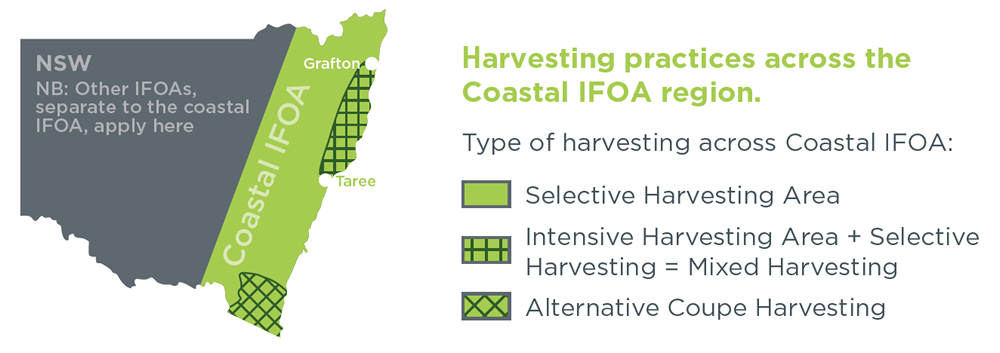Reducing the cumulative impacts of forestry operations in the Coastal IFOA
The Coastal IFOA includes limits on the harvesting practices used by Forestry Corporation NSW to ensure harvesting operations are distributed across the landscape and over time, to support a mosaic of forest age classes and maintain forest structure in the operational area or local landscape area.
The Coastal IFOA permits 4 harvesting practices that may occur in certain logging zones. These are:
- Intensive harvesting in the intensive harvesting zone
- Selective harvesting in the selective harvesting zone (and the entire Coastal IFOA regions)
- Mixed intensity harvesting in the intensive harvesting zone
- Alternate coupe logging in the alternate coupe logging in Eden sub-region.

The Coastal IFOA prescribes where these forms of harvesting are permitted, and specific limits to balance environmental outcomes.
The Coastal IFOA states that no more than 10% of the net harvest area of a management zone can be harvested in a financial year and no more than 5% of that area can be subject to intensive harvesting.
The harvesting limit settings in the Coastal IFOA are also supported by comprehensive mapping requirements and a monitoring, evaluation, review and implementation framework, to ensure any potential environmental impacts are identified and adaptively managed into the future.
Limits and controls on intensive harvesting
Intensive harvesting is a type of harvesting operation with high levels of tree removal and ground disturbance undertaken to promote regeneration. It is largely restricted to Blackbutt dominated regrowth forests between Grafton and Taree in northern New South Wales.
The following limits apply to ensure timber harvesting is distributed over time and across the landscape.

Intensive harvesting is proposed to be carried out over 3 cycles. Each cycle will be separated over time and across each mapped local landscape area. This approach has been designed to balance operational needs, forest regeneration and native species persistence and re-colonisation of harvested areas.
An example of how intensive logging cycles apply to coupes over time and across the local landscape area is below:

Limits will also apply to coupes that are located next to one another. After harvesting is completed in one coupe, 10 years must go by before starting to harvest in an adjacent intensive harvesting coupe, unless an area of permanent exclusion zone of more than 40 metres occurs between the coupes.
Additional controls apply to intensive harvesting operations including that tree retention clumps must be implemented within each coupe, along with hollow-bearing tree, giant tree and feed tree retention requirements.
Limits and controls on selective harvesting
Selective harvesting is the most common harvesting practice in coastal timber production forests. Selective harvesting is a harvesting operation that selectively removes trees from the harvest area within the selective harvesting limits. Selective harvesting limits differ for Regrowth and Non-regrowth zone forests with the aim of maintaining the existing forest structure. Typically, regrowth forests are younger forests with few old-growth elements while non-regrowth forests are more multi-aged, have a more complex structure and contain more older and larger trees.
To retain a suitable density, structure and tree size after harvesting a minimum retention rate, known as ‘basal area’ applies. It sets out the density of trees to be kept in the forest. A minimum basal area of:
- 10 square metres of trees per hectare will be retained in regrowth forests
- 12 square metres of trees per hectare will be retained in non-regrowth forests.
Limits and controls on mixed intensity harvesting
Mixed intensity harvesting includes harvesting operations in local landscape areas in the intensive harvesting zone where both intensive harvesting and selective harvesting occurs or is proposed to occur.
Before starting to harvest in a local landscape area, the selective and intensive harvesting areas must be defined in a map known as a ‘tract’ map.
The selective and intensive harvesting rules described above apply in the tract mapped areas. Site specific limits will also apply to areas where intensive harvesting is planned for more than 25% of the net harvest area in each harvesting cycle.
Limits and controls on alternate coupe logging
Alternate coupe logging is a type of intensive harvesting that applies only in the Eden subregion in southern NSW and has limits set out in the Coastal IFOA. The rules for this practice are similar to intensive harvesting.
Forestry Corporation’s planning processes
Read details of the Forestry Corporation of NSW’s harvest planning processes which include long-term, tactical and operational planning.

